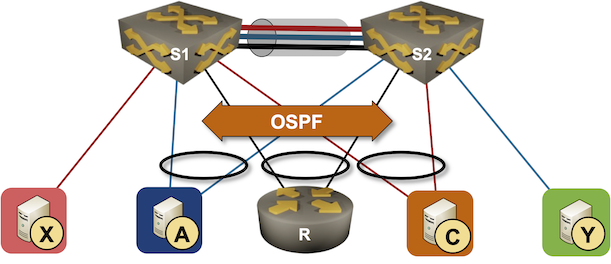The Many Types of VPN
 I'm not sure this is all of them ?
I'm not sure this is all of them ?
Fortinet Rolls Out Cloud-Native Firewall at AWS Re:Invent
In almost every aspect of infrastructure, AWS offers a "basic" product, but partners provide more advanced capabilities. That's the case with this new firewall service.Why Would You Need an Overlay Network?
I got this question from one of ipSpace.net subscribers:
My VP is not a fan of overlays and is determined to move away from our legacy implementation of OTV, VXLAN, and EVPN1. We own and manage our optical network across all sites; however, it’s hard for me to picture a network design without overlays. He keeps asking why we need overlays when we own the optical network.
There are several reasons (apart from RFC 1925 Rule 6a) why you might want to add another layer of abstraction (that’s what overlay networks are in a nutshell) to your network.
Why Would You Need an Overlay Network?
I got this question from one of ipSpace.net subscribers:
My VP is not a fan of overlays and is determined to move away from our legacy implementation of OTV, VXLAN, and EVPN1. We own and manage our optical network across all sites; however, it’s hard for me to picture a network design without overlays. He keeps asking why we need overlays when we own the optical network.
There are several reasons (apart from RFC 1925 Rule 6a) why you might want to add another layer of abstraction (that’s what overlay networks are in a nutshell) to your network.
Network Automation with CUE – Working with YANG-based APIs
In the previous post, I mentioned that CUE can help you work with both “industry-standard” semi-structured APIs and fully structured APIs where data is modelled using OpenAPI or JSON schema. However, there was an elephant in the room that I conveniently ignored but without which no conversation about network automation would be complete. With this post, I plan to rectify my previous omission and explain how you can use CUE to work with YANG-based APIs. More specifically, I’ll focus on OpenConfig and gNMI and show how CUE can be used to write YANG-based configuration data, validate it and send it to a remote device.
Automating YANG-based APIs with CUE
Working with YANG-based APIs is not much different from what I’ve described in the two previous blog posts [1] and [2]. We’re still dealing with structured data that gets assembled based on the rules defined in a set of YANG models and sent over the wire using one of the supported protocols (Netconf, Restconf or gNMI). One of the biggest differences, though, is that data generation gets done in one of the general-purpose programming languages (e.g. Python, Go), since doing it in Ansible is not feasible due to the Continue reading
How Modern, Open Technologies Can Boost Recruiting and Retention
From languages to tools to culture and methodologies, adopting and using open technologies – of the sort exemplified in many DevOps toolchains, for example – will have a compounding positive impact on tech talent in your organization.New! Free self-paced workshops for containers and Kubernetes
There’s no better way to learn something than to get hands-on. Tigera is excited to present its brand new (and completely free!) self-paced workshops for containers and Kubernetes. Each workshop comes with your own provisioned sample application (Hipstershop) and Calico Cloud lab environment for a limited time.
The first self-paced workshop we’ve launched is on compliance for containers and Kubernetes. Let’s take a closer look at why you should enroll in our compliance workshop and what you’ll gain.
Why get hands-on with achieving compliance?
From the Payment Card Industry Data Security Standard (PCI DSS) to the Health Insurance Portability and Accountability Act (HIPAA) to the General Data Protection Regulation (GDPR), most industries must meet certain compliance requirements when it comes to handling personal data. This could mean implementing resource access control, isolating workloads with sensitive data, or enforcing more advanced security controls such as logging all customer confidential data transactions. No matter what sort of controls you need to implement, the compliance auditor will require proof of compliance, such as what security controls are currently in place, whether control changes can be detected, and if compliance can be verified on demand. The ephemeral nature of Kubernetes can make it Continue reading
Running Routing Protocols over MLAG Links
It took vendors like Cisco years to start supporting routing protocols between MLAG-attached routers and a pair of switches in the MLAG cluster. That seems like a no-brainer scenario, so there must be some hidden complexities. Let’s figure out what they are.
We’ll use the familiar MLAG diagram, replacing one of the attached hosts with a router running a routing protocol with both members of the MLAG cluster (for example, R, S1, and S2 are OSPF neighbors).

Running Routing Protocols over MLAG Links
It took vendors like Cisco years to start supporting routing protocols between MLAG-attached routers and a pair of switches in the MLAG cluster. That seems like a no-brainer scenario, so there must be some hidden complexities. Let’s figure out what they are.
We’ll use the familiar MLAG diagram, replacing one of the attached hosts with a router running a routing protocol with both members of the MLAG cluster (for example, R, S1, and S2 are OSPF neighbors).
